February was a quiet month, most days having had just a touch of spring warmth about them, although we finished at the end with colder temperatures. Very little rain fell, so that our rivers had dropped almost to summer levels by the end of the period. The last of the grayling fishing was rather patchy, although the Lugg in N Herefordshire continued to produce reliable catches. Coarse anglers on the Wye had better results and it was warm enough for the barbel to continue feeding.
To kick off the results, PC from Bristol fished at Sugwas Court on 1st February and caught one of the big Wye pike: 21 pounds 1 ounce on a float-ledgered smelt. On the 3rd MH from Llandrindod Wells fished with trotting gear once more around the Wye / Irfon junction at Builth Wells and accounted for 17 grayling. On the 7th CC from Cheltenham was another who had a great day trotting the Lugg at Eyton, catching 15 grayling from 10-16 inches. PT from Kidderminster fished the same beat on the 12th and lost count of grayling caught up to 1lbs 12 oz. TH from Swansea with a friend fished at Wyebank near Lydbrook on the 14th and they caught 12 chub between 2 and 4 pounds.
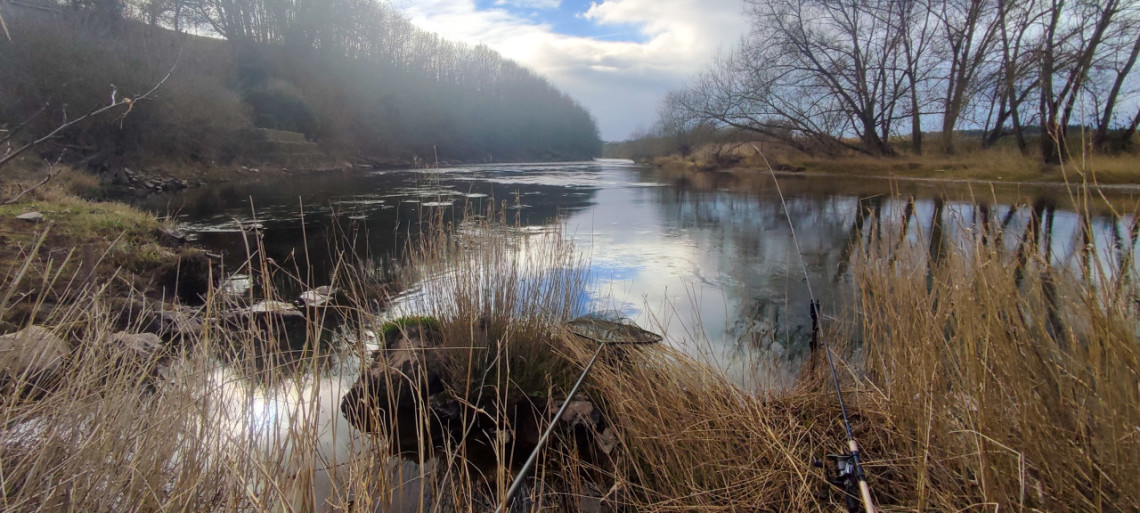 Fownhope 5 - NB from Bristol
Fownhope 5 - NB from Bristol Warmer weather and a little colour in the Wye’s main stem may have helped MH from Llandrindod Wells on his regular GPAIAC beat at Builth Wells to catch 31 grayling with the trotting rod. MJ from Kington managed 4 grayling trotting the Irfon at Melyn Cildu. DE from Worcester with a friend were on the Lugg at Lyepole the following day and together they accounted for 30 grayling of various sizes. DE told us he was trotting with “an old Bruce and Walker float rod” which he had recently acquired. Fair enough; my own favourite trotting rod is actually an old fibre glass model and I doubt I could find a new one quite like it today.
Focussing back on coarse fishing for a moment, on the 19th PT from Kidderminster with a friend fished at Holme Lacey and Lechmere’s Ley. They accounted for 23 chub and a barbel, but found a maggot feeder was working better than the float.
 Difficult fishing on the Lugg at Eyton
Difficult fishing on the Lugg at Eyton 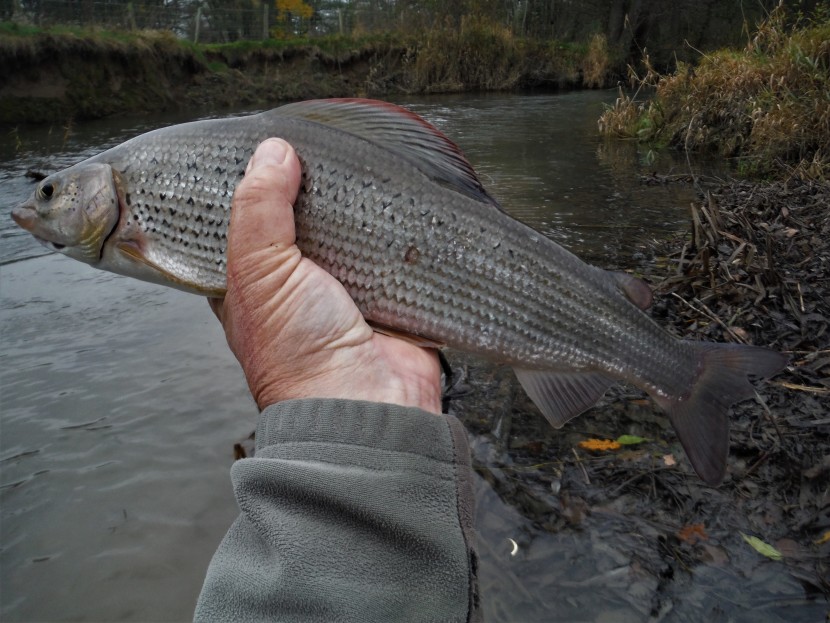 Eyton grayling
Eyton grayling BH from Oxford had a good day trotting the Lugg at Lyepole on the 22nd, accounting for 17 small grayling. AG from Hoddesdon had 18 barbel and 9 chub from the Creel, this being quite typical of coarse fishing reports from the Wye this winter. On the 23rd TL from Kingsland had a nice time in the Golden Valley at Abbeydore, winkling 3 grayling out of the stream with a nymph, later touring the abbey and I note that he found the place which sells home-made cider on his way home. These all strike me as the essential ingredients of a good Wild Stream day! However Joe Alexander, now of Rhayader, fished the Ithon at Llandewi for some small grayling and expressed concern at how low some of the headwater streams were becoming. On the 25th SP from Eastnor caught 9 grayling at Lyepole, not by trotting but with nymphs. He did emphasize that he did not wade.
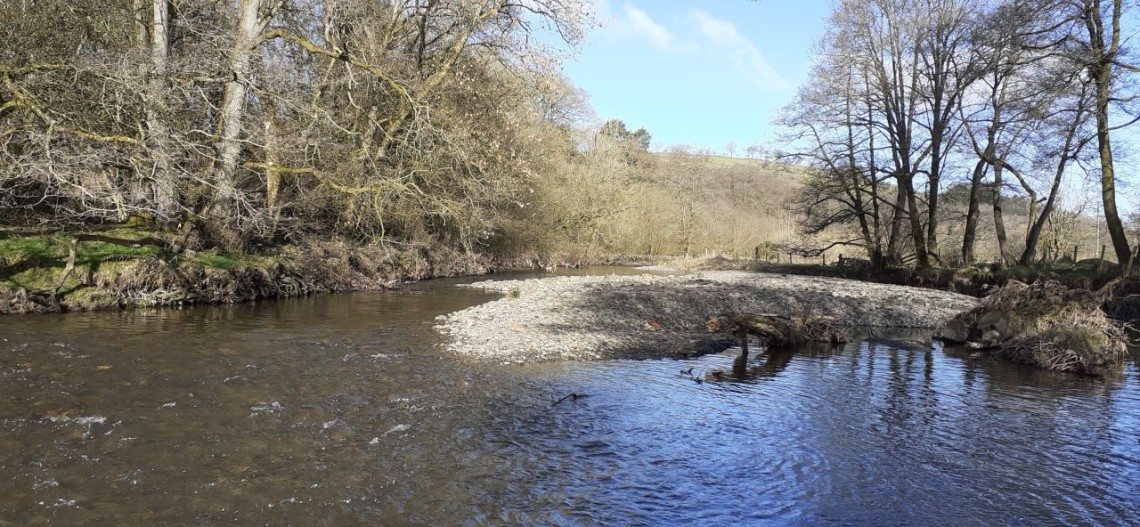 Llandewi - JA from Rhayader
Llandewi - JA from Rhayader During a long court case and while the matter was sub judice I have been unable to write about the vandalism of the Lugg which took place at Dayhouse Farm as long ago as October 2020. However, now that we have a verdict I can describe what I know about it. I feel strongly about the affair because I believe I was the last angler to see this stretch of river as it used to be. Dayhouse Farm, with its riffle, pool and run sequences over clean gravels, stable between its banks anchored by alders and willows, absolutely typical of these pretty streams of the Marches, was a favourite autumn grayling fishery for many of us. I remember how proud Seth and Chris of the Foundation were when they managed to recruit it onto the Passport scheme.
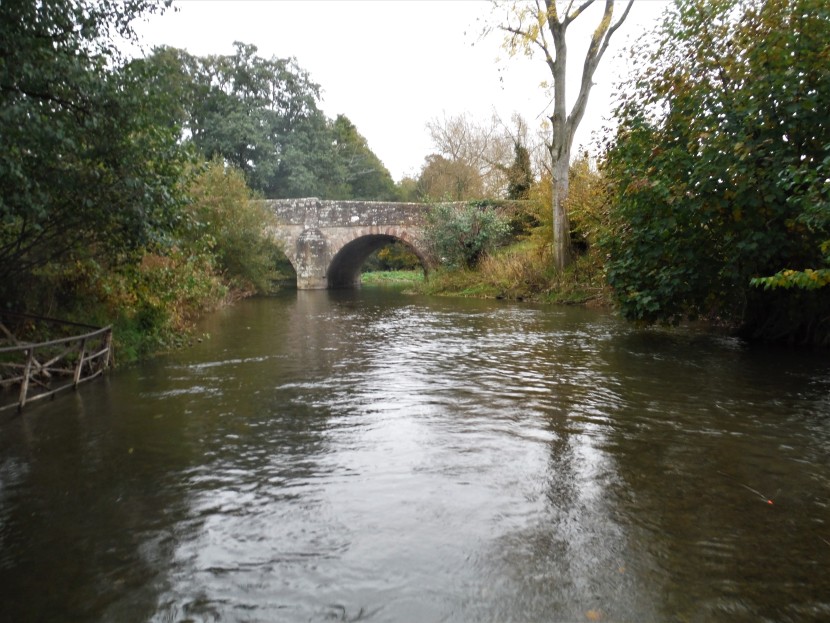 Dayhouse Bridge on the Lugg
Dayhouse Bridge on the Lugg 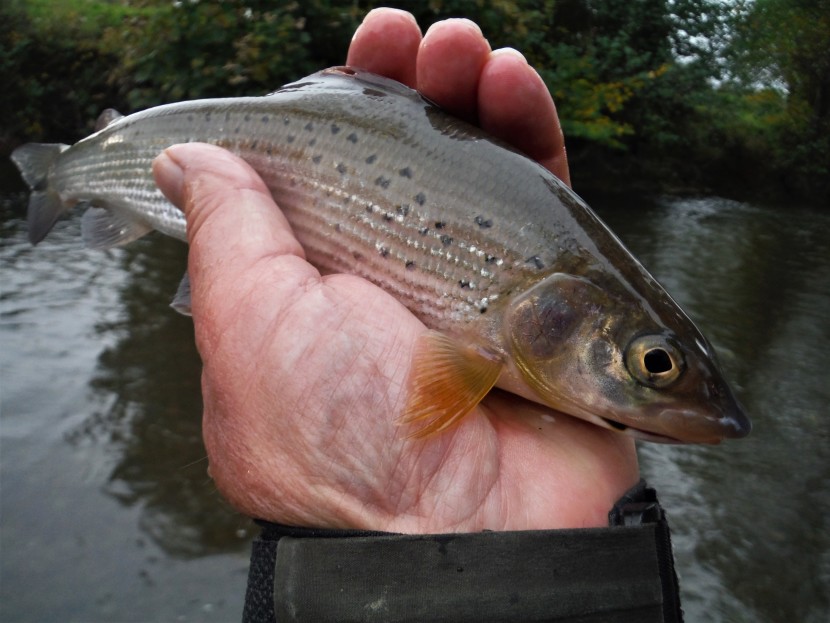 Dayhouse grayling
Dayhouse grayling My own Dayhouse fishing that autumn was on October 24th , which was a sunny day with the river running high but fairly clear, and I had no inkling of what was about to happen. The leaves of bankside trees were then in a blaze of colour. I went up from the bridge at the bottom, after some indecision using a pair of nymphs rather than dry flies, caught a few modest grayling and then showed my ticket to the landowner who came over in a 4WD when I was abreast of his house. I asked him about a recently banked up pile of gravel on the outside of a bend and was told that the bank was being reinforced there due to flood damage, but the digging machine had been sent away for repairs that day. He invited me to wade on through the same bend, normally forbidden to anglers due to the proximity of the house, but I found I could not do so due to the increased depth and soft river bed. That seemed slightly odd, as did the idea of piling up gravel to prevent flooding, but I’m afraid I thought no more about it at the time. I made my way further up to the top of the beat as normal and caught a few more grayling before spending some time trying to take photographs of a large otter which was now busily fishing one of the runs I had just been through. The otter didn’t seem too concerned about my presence. Altogether it was a very happy few hours on a lovely autumn day in a lovely place.
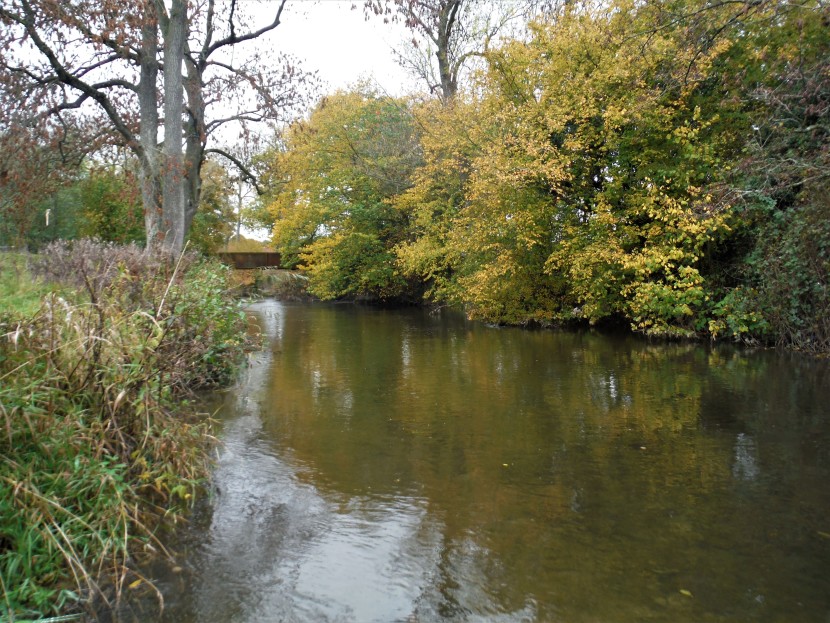 Dayhouse October 2020
Dayhouse October 2020 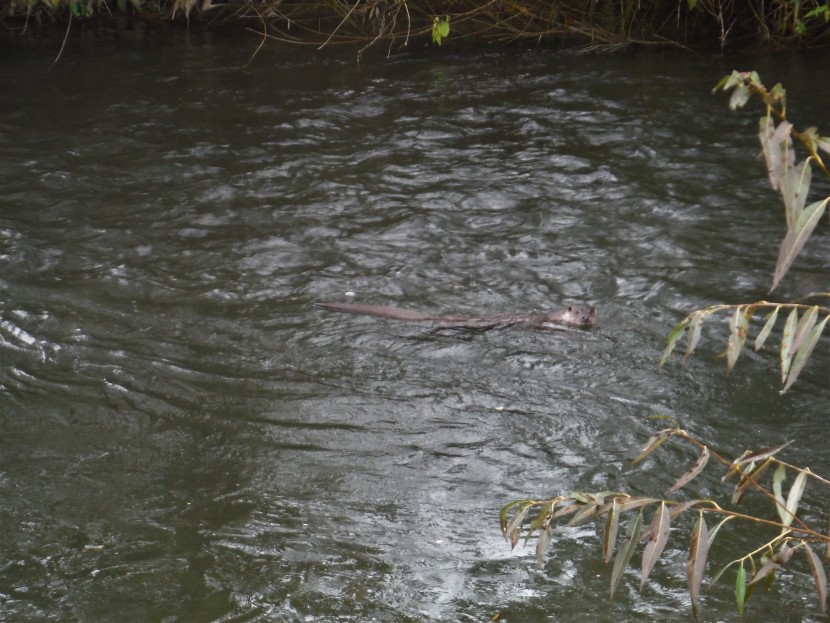 Dayhouse ottter, October 2020
Dayhouse ottter, October 2020 A few days later, there was a sudden furore about Dayhouse involving everybody from Herefordshire Police and the EA to Forestry England, Natural England and the Herefordshire Wildlife Trust. It was a Foundation member of staff who first happened to look over the bridge and realised that the bulldozer already mentioned had now created a straightened canal nearly a mile long, with 45 degree sloping banks of mud. The trees had all gone. The pictures tell the story better than any words of mine can.
The upset was considerable and the Herefordshire press was full of the affair, but the landowner, Mr Price of Dayhouse Farm, remained unrepentant, claiming he had the support of the local community for the work. Various facts came to light to complicate the matter, including a failed attempt to gain planning permission for houses on some of the riverside land and complaints of flooding in some nearby cottages. The landowner also referred to, of all things, a Parish Council meeting, at which he had apparently agreed at his own expense to clear mud which was partly blocking one of the three arches of the bridge at the very bottom of the beat. (This, from what I saw as I entered the river, probably did need doing. At the same time, I’m reminded of the occasion a neighbour approached my wife when I was away abroad saying that a small tree in our garden was obstructing his view a little and would she mind if he pruned the top very slightly? When she got back from the shops, the whole tree had been grubbed out by the roots and had disappeared!) According to one account, two EA staff members were apparently at this Parish Council meeting; if true, it would be interesting to know from the minutes what was and wasn’t said about this proposed work.
 Devastated Lugg at Dayhouse after the bulldozer
Devastated Lugg at Dayhouse after the bulldozer At first it seemed that the EA were not going to be prosecuting in this case. “So the landowner has been vindicated then?” said a non-fishing friend of mine. That would probably have been the public perception of the matter if no prosecution had followed, and there are already examples of similar damage on a smaller scale more recently inflicted on rivers in Herefordshire. At the same time some farming associations and parts of the media were began to present the case as one of “local farmer bullied by environmental organisations.” However, the case eventually went forward and somebody must have had a word in the ear of Mr Price because the blustering stopped and he changed his plea to guilty on seven counts. Even now we still await the sentencing decision and some plan as to how the river might be restored to its original condition. Possible sentences include imprisonment and/or very heavy fines; the assumption is that a fine might be based on the cost of restoration, assuming that restoration is even possible. Considering the scale of this dredging and tree grubbing operation which breached so many regulations, the time and difficulty involved to mount a prosecution seems to have been absolutely extraordinary. Every organisation involved expressed horror at what was done. However, perhaps altogether too many organisations were involved, which may be one of the problems we have in managing the environment in the UK?
The March edition of Trout and Salmon includes two articles about fishing North Country spiders which are effectively complementary, whether or not this was intended. On page 92 Stuart Foxall describes a March Brown spider pattern by Usk angler Paul Slaney, a pair of which are intended to be fished “awash” up and across to rising fish. And on page 82 Paul Proctor describes how to fish a leash of spiders across and down to search for non-rising fish. Take notice of the need to hold the rod high, so that a taking fish has some slack to go down with before the hook sets. Upstream or downstream, whether you are a devotee of Stuart or Pennell, both of these described methods can be very effective when fishing wet flies during the spring. There is no “right” or “wrong” way to fish spiders on rivers in my opinion.
I had a birthday during the month and the family insisted on taking me for a day out based around the Penderyn whisky distillery. I wasn’t driving, by the way. We also had a walk around what is known in South Wales as “waterfall country,” which involves the steep valleys worn through sandstone and limestone by the headstreams of the River Neath. I must admit that I have never fished the Neath, although it has a reputation for a late run of salmon and some large sewin. A lot of water was still running over the falls on this particular day and apart from the native brown trout I could imagine some exciting late season fishing for migratory fish. Most of the river is in the hands of the Glynneath and District Angling Association and note that you can buy a ticket via the Wye and Usk Foundation.
In March 1992 I made a long and somewhat leisurely drive around Eastern Turkey. I was on leave at the time, so I was in no particular hurry, although I had been given a little extra holiday task, which was to keep my eyes open for signs of sanctions-breaking along the Iraqi border. This was in the wake of the previous year’s Desert Storm War against Saddam Hussain. Most of inland Anatolia has a rather brutal landscape, owing more in character to Central Asia than to Europe. There is beauty in places, but it is beauty on a huge and daunting scale: snow-capped mountains and tawny moors separated by wide valleys, with few trees to relieve the monotony, stretches of black rock and the bleak human settlements lying far apart. The long pockmarked road goes limping ahead into the distance. Desolate in dusty ground, a camel’s march apart, the khans of the old Silk Road stand abandoned. Nobody uses caravanserais now, but the line of ancient buildings still stretches all the way from Europe to China. Modern villages are or were poor with many traditional single storey houses of mud-brick and straw and the towns mostly notable for ugly modern apartment buildings of reinforced concrete. Antiquities, churches and mosques, looked sadly neglected. Overall it’s a vast tract of land, across which a traveller using the antiquated railway system, at that time still sometimes hauled by steam, needed a couple of days from Istanbul to reach the Iranian border in the East.
The long running war between the Turkish Army and Kurdish separatists was evident in the number of military checkpoints on the roads. Some of these would reputedly be abandoned by the Army at 5 o’clock and run by the PKK during the hours of darkness. This sounds slightly sinister, but Turkish country people including Kurds were invariably kind, at least to a stranger. There was then, if not now, one major difference from Western Turkey, in that the male traveller did not meet women in public facing roles, whether in the country or the town. Women in the fields would cover their face and turn their back, even when innocently asked for directions. Anatolia is not Europe, for all the modernising efforts of Kemal Ataturk a century ago.
I have some memory pictures from those days of journeying, including stopping by flocks to talk to the shepherd about his huge Anatolian sheep dog. He asked if I was a soldier and told me had been a parachutist and took part in the 1974 invasion of Cyprus. The dog had yellowed canine teeth like those of a lion. Lines of refugee tents in the south along the border with Syria. The sight of a railway repair crew aboard an old-fashioned inspection car, pumping the handles up and down as they dwindled into the distance. Blackened Armenian churches which had lain unused since the genocide of 1915 except to house goats and sheep. Boys in the ruinous back suburbs of Erzerum surprised smoking opium from a bong. Russian architecture still to be seen near Kars, and lines of watch towers on the distinctly unfriendly border with Armenia in the east. This area has a terrible history of wars and pogroms, constantly changing hands between the empires and cultures of competing peoples: Greeks, Persians, Armenians, Turks and Russians. Driving around the back of Mount Ararat, whose lofty cone dominates the landscape for 100 miles around, I reached the blue jewel of Lake Van, big enough for an inland sea. On the shore where mullet nets were stretched to dry, I was invited by fishermen into their stove-heated bell tents.
In a small hotel in Van city I came across a dark-haired man with apparently a bad temper, leader of a group of denim-clad workers. In English he was giving the reception staff a very hard time about his bill. Later I had dinner at his table and learned he was a Croatian mining engineer with a contract to drill rock samples on the site of a dam which was building on the Iranian side of the border. Every 6 months his team had to come out to renew their visas. His workers were all Bosnians who were queuing up to use the phone, desperately worried about political developments and the threatening conflict in their home country. The Croatian team leader didn’t give the impression of caring much, although he had plenty to say about his own nation’s recent war with Serbia.
I didn’t have to look far for evidence of sanctions breaking. It seemed that every Turkish trucking company or private owner, if they didn’t own purpose-built tankers, had arranged for sheet metal tanks holding thousands of litres to be welded up and bolted to the sides of each lorry chassis. In their hundreds these make-shift tanker trucks were lined up blocking the roads leading south to the border with Iraq and the Kurdish autonomous region created by NATO’s no fly zone after Desert Storm. Blue “evil eyes” painted on the back of the trucks were intended to protect against bad luck. From the Kurdish-controlled region drivers pushed right on down to Saddam’s northern-most oil field at Kirkuk where they loaded up crude, before returning with brimming tanks on dangerous oil-slick roads to Turkey. Here they discharged into the refinery at Batman or sold it on the black market. Big money was being made and the Kurds were surely taking their cut.
One particular memory from that trip is driving through the town of Erzincan, which had experienced a major earthquake just a few days before. It was a sobering experience. The quake had been a powerful one of 6.7 on the Richter scale, killing 500 people and destroying 150 buildings. It lasted only 7 seconds, but almost every traditional mud-brick and straw dwelling had collapsed into a dusty pile. The modern buildings had fared better for the most part, but some concrete apartment blocks had also folded flat like collapsed packs of cards and one long one was tilted from one end to the other like a ship going down by the bow. The population still didn’t trust themselves indoors and were loitering in crowds on the cold streets or sleeping in cars. Encampments of white tents had been raised on the outskirts of town. I remembered thinking to myself that if I ever found myself indoors during an earthquake, I would rather it be a low mud brick building than a tall concrete one.
Several years later, in Sarajevo, I did experience a couple of minor quakes. One tremor rocked the bed gently during the night and hardly woke me. Another was while I was sitting in a Landrover parked in the old town. Again the vehicle unaccountably rocked on its springs and a chunk of masonry fell from the façade of one of the Austro-Hungarian buildings nearby. All was still after a few seconds. Yugoslavia’s really dramatic earthquake came in 1963 when Macedonian capital Skopje was almost completely destroyed. There followed a most amazing national and international reconstruction effort under Communist party leadership. Skopje’s motto today is The City of International Solidarity. There was actually a slight tremor in Gwent during this February, although many people missed it.
Driving beyond Erzincan the reality of the underlying geology of Anatolia became more than obvious. Here was a river valley, but not the kind of valley we are used to in Britain, either V-shaped cut by river water erosion or gouged in a U-shape section by glacier ice. Between two great mountain plateaux, steep slopes led down to a wide valley floor which was absolutely flat. The river, with no big slope to guide it, wandered all over the valley floor in a confused mass of separate ribbons. I was told it had moved its bed during the recent quake. What I was looking at was a kind of rift valley known here as the North Anatolian Fault. Here two great tectonic plates, Eurasian and Arabian, butt up against each other, slowly pushing, rubbing and building up pressure until suddenly they jerk free and the earth moves.
I sometimes remind myself to be grateful that I don’t live in an area where there are serious geological faults, or which is at risk from volcanoes or subject to floods. Last month we were all moved and shocked by the news from Turkey and Syria where it is now estimated that two earthquakes in quick succession killed over 50,000, wounded perhaps 150,000, destroyed over 50,000 buildings and displaced some 6 million from their homes. I worked for many years in the field of emergency relief, but mine were all what they call “slow onset emergencies,” which in practice means armed conflict. In a sense, those are the easy kind. “Sudden onset emergencies” are typically floods, tidal waves or earthquakes and I have a tremendous admiration for those teams of specialists who have the skills to deploy quickly over long distances and set up complex operations within a few days.
Inevitably there is a delay before any emergency operation can be made effective and equally inevitably it is the international journalists who are able to grab cameras and recording equipment and arrive first. At that stage even the local assistance will just be getting into gear. How could it be otherwise? And just as inevitably, in the first hours and days the desperate local population will cry: “There’s no help – will anybody come to save us?” The international media typically repeat and broadcast this initial lack of assistance as a strap-line without much analysis. In the case of Turkey, some of our UK-based “famous faces” took their accustomed line of blaming the government for everything whatever the circumstances, and were then rather surprised to get their wrists slapped. Turkey is not the UK and the government responded by asking their citizens to report examples of fake news or anti-government propaganda circulating. That does seem rather sinister, but clearly the Turkish government is not prepared to be kicked around by journalists in the way that the government of the UK is. At least that should be food for thought for those standing in front of the cameras.
By the end of the first week the world was beginning to realise that this was not just another Anatolian earthquake but the worst natural disaster in the region for a century. 10 provinces of Anatolia were affected along with a large area of northern Syria. The earth’s crust had moved 7.5 metres. “People’s homes have become their graves” a shocked local reporter remarked while contemplating a devastated Turkish city. Even after a week, survivors were still being rescued alive from the rubble, although the temperature was falling and snow fell in some areas. There was another quake measuring 6.4 near Antakya on 20th February. This one collapsed already damaged buildings and killed several more people, spreading even more terror.
I took to watching TRT World, always worth a look, but now the only one providing 24 hour disaster coverage. In fact the Turkish government’s response was becoming quite impressive, even allowing for controlled and sympathetic media reporting. Like other large Middle Eastern countries and in particular Iran, the administration is organised on something like a war footing. Turkey has a huge army and a powerful Red Crescent with large stocks of tents, blankets and other emergency items. A state of emergency in the 10 provinces was declared for three months. The Interior Ministry’s disaster response agency AFAD co-ordinated the effort, beginning with the supply of tents, blankets and sanitary materials and organising of public kitchens. There was a real concern about the risk of such diseases as cholera and typhoid among the displaced population unless sanitary conditions could be provided. Turkey had appealed for a very specific and limited international emergency assistance during the first hours. This mainly consisted of specialist rescue teams with sniffer dogs. The medical system had immediately come under great strain and appreciated help. Looking forward, the WHO appealed for 90 million USD and began to deploy its largest ever medical response. The UN as a whole made a first appeal for 400 million USD.
Meanwhile the local assistance, including cranes and earth moving machines from builder’s yards and teams of volunteers, formed the main component of the first effort. After a week the efforts of the Army and other state actors in opening damaged roads and airports for the logistics operation to follow was more apparent. Day by day a growing wave of sympathy came from around the world. Jens Stoltenberg stated this was the worst disaster ever to befall a NATO member, President Erdogan made a claim, probably justified, that Turkey was now facing a situation similar to that which would have been produced by a major nuclear attack. The Greek Foreign Minister Dendias made an early tour of the disaster areas and sent a rescue team. In Britain the Disasters Emergency Committee met and started an appeal, while some old friends such as Islamic Relief of Birmingham within a few hours had despatched trucks on the three day drive to Turkey. In the longer term, obviously the Turkish Government and Red Crescent will appreciate donations to replenish stocks and there will certainly be a grateful receipt of aid grants to rebuild infrastructure and housing over the years to come. International aid was already on the way to Assad’s Syria. Hezbollah sent a convoy of 20 trucks of aid north from Lebanon. Due to the security situation, aid and reconstruction in the opposition-held areas of Syria across the border will probably mostly be handled by the UN who are co-ordinating the main international appeal.
Some of the international journalists now in Turkey might find it worth their while before they leave to investigate just why it is that so many modern concrete buildings collapsed so easily. The Grenville Tower disaster in London provoked a huge outcry from the UK public and much soul-searching about how and why it happened. An earthquake in Turkey could hardly have been unexpected. Unfortunate it may be, but much of the country has always been known to be affected by the earth-quake risk. Accordingly, Turkey has long possessed quite an impressive array of specialists in the geology of the region and also of engineers versed in quake-proof construction. For many years now the building regulations, particularly regarding quake-proofing, have been of a high international standard. And yet we are told that in some areas as many as half the buildings recently constructed and occupied did not meet the standards, but were nevertheless somehow signed off. We might ask ourselves why that could possibly happen. Are lessons going to be drawn from the disaster and will the standards now be applied properly? Voices in Turkey are already clamouring for an accounting and arrest warrants have been issued for 131 building contractors suspected of criminal negligence. One was arrested in North Cyprus, another at Ankara Airport when about to board a plane for Montenegro. Of course for every bribe that was paid, there was a recipient. I imagine some officials will be feeling quite nervous.
Someone calculated that the UK has spent an extra 50 billion pounds on gas during the first year of the Ukrainian War. Money on munitions for the war is pouring out faster than ever. Before that, huge amounts were spent on the pandemic and those debts will have to be repaid. On the other hand, guess what, we aren’t in a recession! One less thing to worry about, I thought to myself. During February we learned, despite gloomy predictions from the likes of the Bank of England, OBR and the International Monetary Fund, that the UK together with Germany and France have all just about missed joining the US in a technical recession. So far, that is. And of course the mentioned financial organisations are famous for being wrong, which is nothing new in the financial world. I don’t recall anybody predicting the 2008 crash.
Every time I hear somebody warning me about a looming recession, I’m reminded of the story of the Greek guy who migrated to the US and opened a restaurant in New York. Full of enthusiasm in the new country he worked hard serving souvlakia and avgolemeno to appreciative New Yorkers, his reputation grew and his business did well. After a bit he opened a second restaurant run on the same pattern and then a third, so that over the years he made quite a bit of money. Now this chap had a son who he had always imagined would go into the business with him and when the boy finished college the father realised he could afford to send him to do a course at the Harvard Business School. What a triumph for the family and God bless America!
After his course the boy came back to work in the business, but after a couple of months he sat his father down and gave him some serious suggestions. “Hey old man, don’t you read the Wall Street Journal? There’s a recession coming and I think we need to look at our costs to get through it. Do you realise how much money you spend advertising in all these local papers every week and look how many table staff you have hanging around just to make service quick and friendly? We need to cut back. And this is no time to be planning a fourth restaurant.” The old man wasn’t happy at the thought, but he knew his educated son must be right, so he cut the advertising budget and let some waiters go, gave up his idea of the extra restaurant on the upper West Side and then hunkered down to ride out the storm.
After a couple more months the old man did his accounts and saw that the takings were down 40%. He was so impressed, that he had to ring a friend. “Hey Stavros, my boy said a recession was coming and he was right! You see the value of education?”
The world may be in a bad state but we fish on! The rivers are in condition at the moment and it all starts again on 3rd March. Look out for midday hatches and be ready for some of the best wild trout of the season. Trout fishers may find it cold at first, but something usually happens around midday, first with large dark olives and later in the month March browns. With a bit of luck, we might see some grannom sedge on sunny days. There might even be a chance of a salmon. Tight lines!
Oliver Burch